BTEC HND Health & Social Care: Understanding the Learning Process
VerifiedAdded on 2020/06/04
|11
|3525
|126
Report
AI Summary
This report provides a comprehensive analysis of the learning process within the health and social care sector. It begins with an overview of different learning domains and ways in which learning can occur, referencing Kolb's learning cycle and various learning styles such as activist, pragmatist, reflector, and theorist. The report then explores the influence of learning theories on skill development and understanding, followed by an examination of factors that impact learning effectiveness, including motivation, environment, communication, and time management. It delves into the concepts of learning styles, including Kolb's and VARK models, and discusses the author's preferred learning style and its relation to learning theory. Furthermore, the report addresses factors to consider when planning workplace learning programs, such as funding, learning mediums, and resources, as well as teaching strategies like seminars, games, and visual presentations. It also covers strategies for delivering and assessing learning, focusing on discussion-based approaches, and concludes by identifying learning barriers and methods for addressing individual learning needs in the health and social care context.
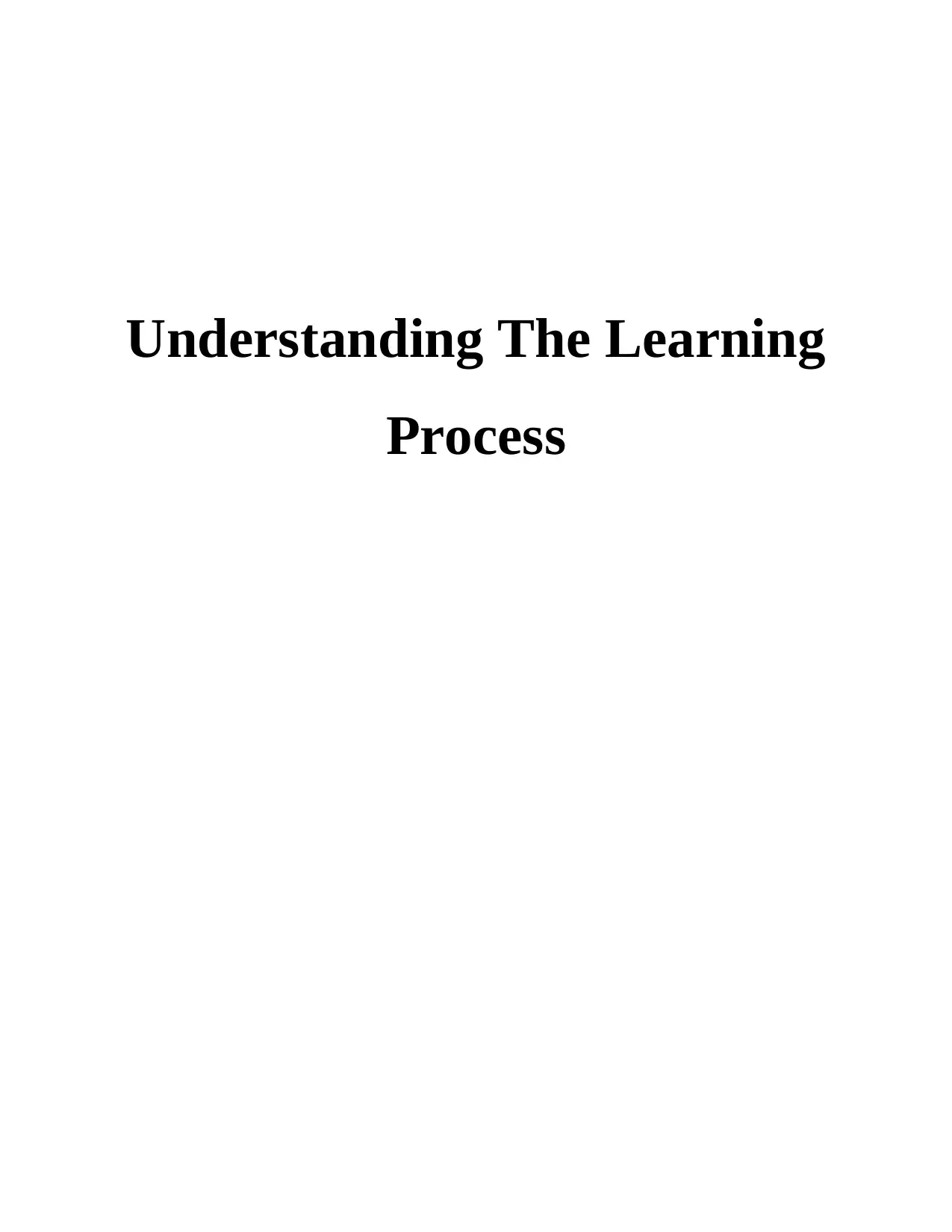
Understanding The Learning
Process
Process
Paraphrase This Document
Need a fresh take? Get an instant paraphrase of this document with our AI Paraphraser
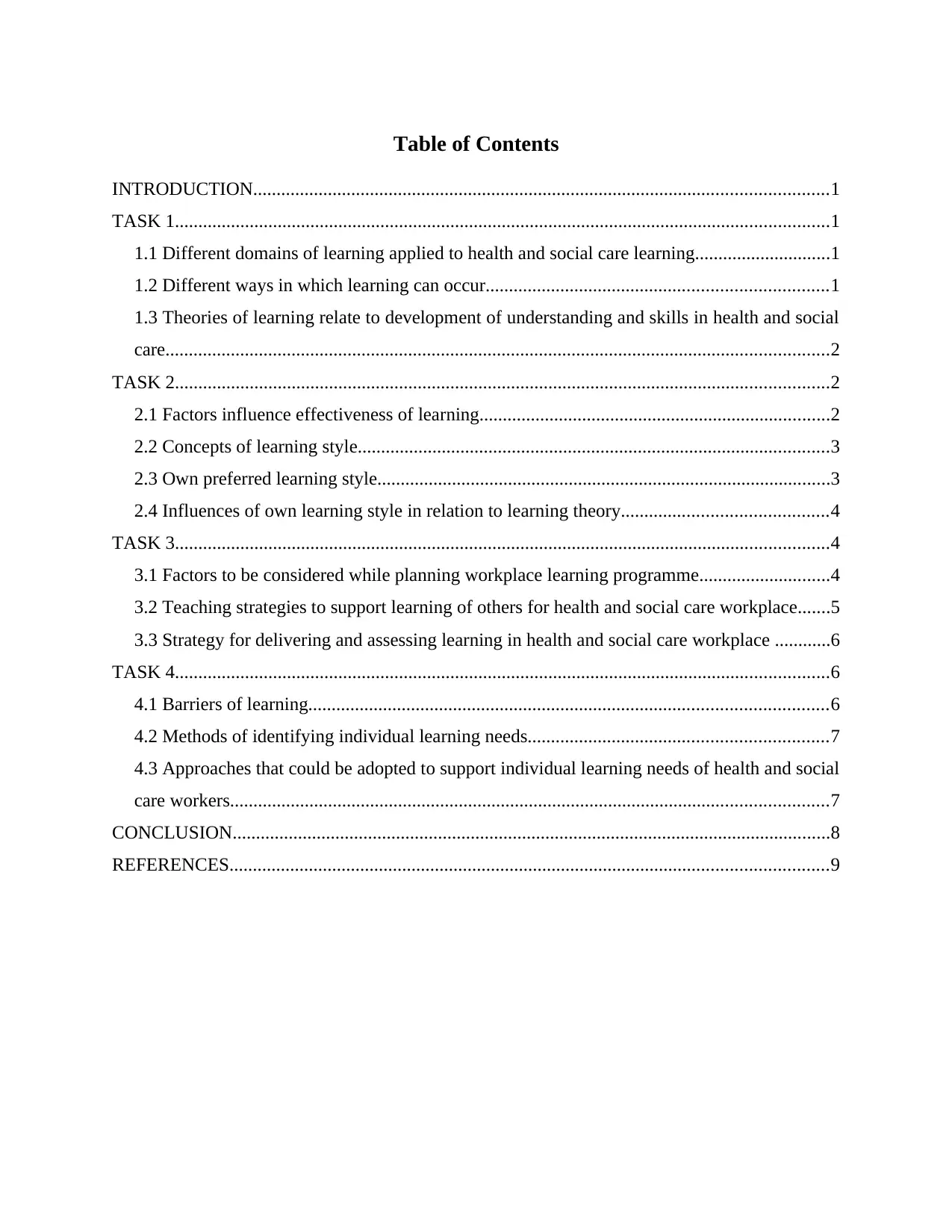
Table of Contents
INTRODUCTION...........................................................................................................................1
TASK 1............................................................................................................................................1
1.1 Different domains of learning applied to health and social care learning.............................1
1.2 Different ways in which learning can occur.........................................................................1
1.3 Theories of learning relate to development of understanding and skills in health and social
care..............................................................................................................................................2
TASK 2............................................................................................................................................2
2.1 Factors influence effectiveness of learning...........................................................................2
2.2 Concepts of learning style.....................................................................................................3
2.3 Own preferred learning style.................................................................................................3
2.4 Influences of own learning style in relation to learning theory............................................4
TASK 3............................................................................................................................................4
3.1 Factors to be considered while planning workplace learning programme............................4
3.2 Teaching strategies to support learning of others for health and social care workplace.......5
3.3 Strategy for delivering and assessing learning in health and social care workplace ............6
TASK 4............................................................................................................................................6
4.1 Barriers of learning...............................................................................................................6
4.2 Methods of identifying individual learning needs................................................................7
4.3 Approaches that could be adopted to support individual learning needs of health and social
care workers................................................................................................................................7
CONCLUSION................................................................................................................................8
REFERENCES................................................................................................................................9
INTRODUCTION...........................................................................................................................1
TASK 1............................................................................................................................................1
1.1 Different domains of learning applied to health and social care learning.............................1
1.2 Different ways in which learning can occur.........................................................................1
1.3 Theories of learning relate to development of understanding and skills in health and social
care..............................................................................................................................................2
TASK 2............................................................................................................................................2
2.1 Factors influence effectiveness of learning...........................................................................2
2.2 Concepts of learning style.....................................................................................................3
2.3 Own preferred learning style.................................................................................................3
2.4 Influences of own learning style in relation to learning theory............................................4
TASK 3............................................................................................................................................4
3.1 Factors to be considered while planning workplace learning programme............................4
3.2 Teaching strategies to support learning of others for health and social care workplace.......5
3.3 Strategy for delivering and assessing learning in health and social care workplace ............6
TASK 4............................................................................................................................................6
4.1 Barriers of learning...............................................................................................................6
4.2 Methods of identifying individual learning needs................................................................7
4.3 Approaches that could be adopted to support individual learning needs of health and social
care workers................................................................................................................................7
CONCLUSION................................................................................................................................8
REFERENCES................................................................................................................................9
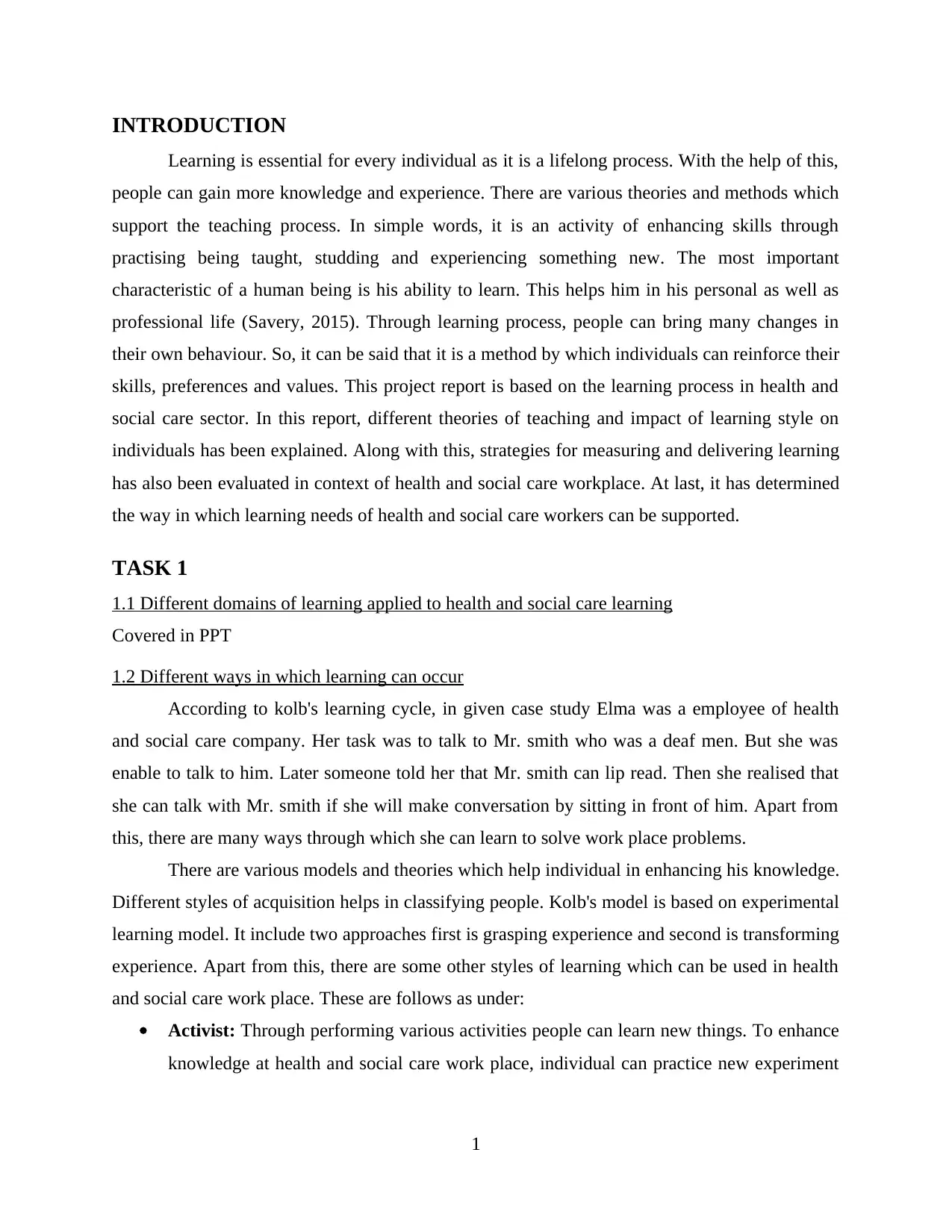
INTRODUCTION
Learning is essential for every individual as it is a lifelong process. With the help of this,
people can gain more knowledge and experience. There are various theories and methods which
support the teaching process. In simple words, it is an activity of enhancing skills through
practising being taught, studding and experiencing something new. The most important
characteristic of a human being is his ability to learn. This helps him in his personal as well as
professional life (Savery, 2015). Through learning process, people can bring many changes in
their own behaviour. So, it can be said that it is a method by which individuals can reinforce their
skills, preferences and values. This project report is based on the learning process in health and
social care sector. In this report, different theories of teaching and impact of learning style on
individuals has been explained. Along with this, strategies for measuring and delivering learning
has also been evaluated in context of health and social care workplace. At last, it has determined
the way in which learning needs of health and social care workers can be supported.
TASK 1
1.1 Different domains of learning applied to health and social care learning
Covered in PPT
1.2 Different ways in which learning can occur
According to kolb's learning cycle, in given case study Elma was a employee of health
and social care company. Her task was to talk to Mr. smith who was a deaf men. But she was
enable to talk to him. Later someone told her that Mr. smith can lip read. Then she realised that
she can talk with Mr. smith if she will make conversation by sitting in front of him. Apart from
this, there are many ways through which she can learn to solve work place problems.
There are various models and theories which help individual in enhancing his knowledge.
Different styles of acquisition helps in classifying people. Kolb's model is based on experimental
learning model. It include two approaches first is grasping experience and second is transforming
experience. Apart from this, there are some other styles of learning which can be used in health
and social care work place. These are follows as under:
Activist: Through performing various activities people can learn new things. To enhance
knowledge at health and social care work place, individual can practice new experiment
1
Learning is essential for every individual as it is a lifelong process. With the help of this,
people can gain more knowledge and experience. There are various theories and methods which
support the teaching process. In simple words, it is an activity of enhancing skills through
practising being taught, studding and experiencing something new. The most important
characteristic of a human being is his ability to learn. This helps him in his personal as well as
professional life (Savery, 2015). Through learning process, people can bring many changes in
their own behaviour. So, it can be said that it is a method by which individuals can reinforce their
skills, preferences and values. This project report is based on the learning process in health and
social care sector. In this report, different theories of teaching and impact of learning style on
individuals has been explained. Along with this, strategies for measuring and delivering learning
has also been evaluated in context of health and social care workplace. At last, it has determined
the way in which learning needs of health and social care workers can be supported.
TASK 1
1.1 Different domains of learning applied to health and social care learning
Covered in PPT
1.2 Different ways in which learning can occur
According to kolb's learning cycle, in given case study Elma was a employee of health
and social care company. Her task was to talk to Mr. smith who was a deaf men. But she was
enable to talk to him. Later someone told her that Mr. smith can lip read. Then she realised that
she can talk with Mr. smith if she will make conversation by sitting in front of him. Apart from
this, there are many ways through which she can learn to solve work place problems.
There are various models and theories which help individual in enhancing his knowledge.
Different styles of acquisition helps in classifying people. Kolb's model is based on experimental
learning model. It include two approaches first is grasping experience and second is transforming
experience. Apart from this, there are some other styles of learning which can be used in health
and social care work place. These are follows as under:
Activist: Through performing various activities people can learn new things. To enhance
knowledge at health and social care work place, individual can practice new experiment
1
⊘ This is a preview!⊘
Do you want full access?
Subscribe today to unlock all pages.

Trusted by 1+ million students worldwide
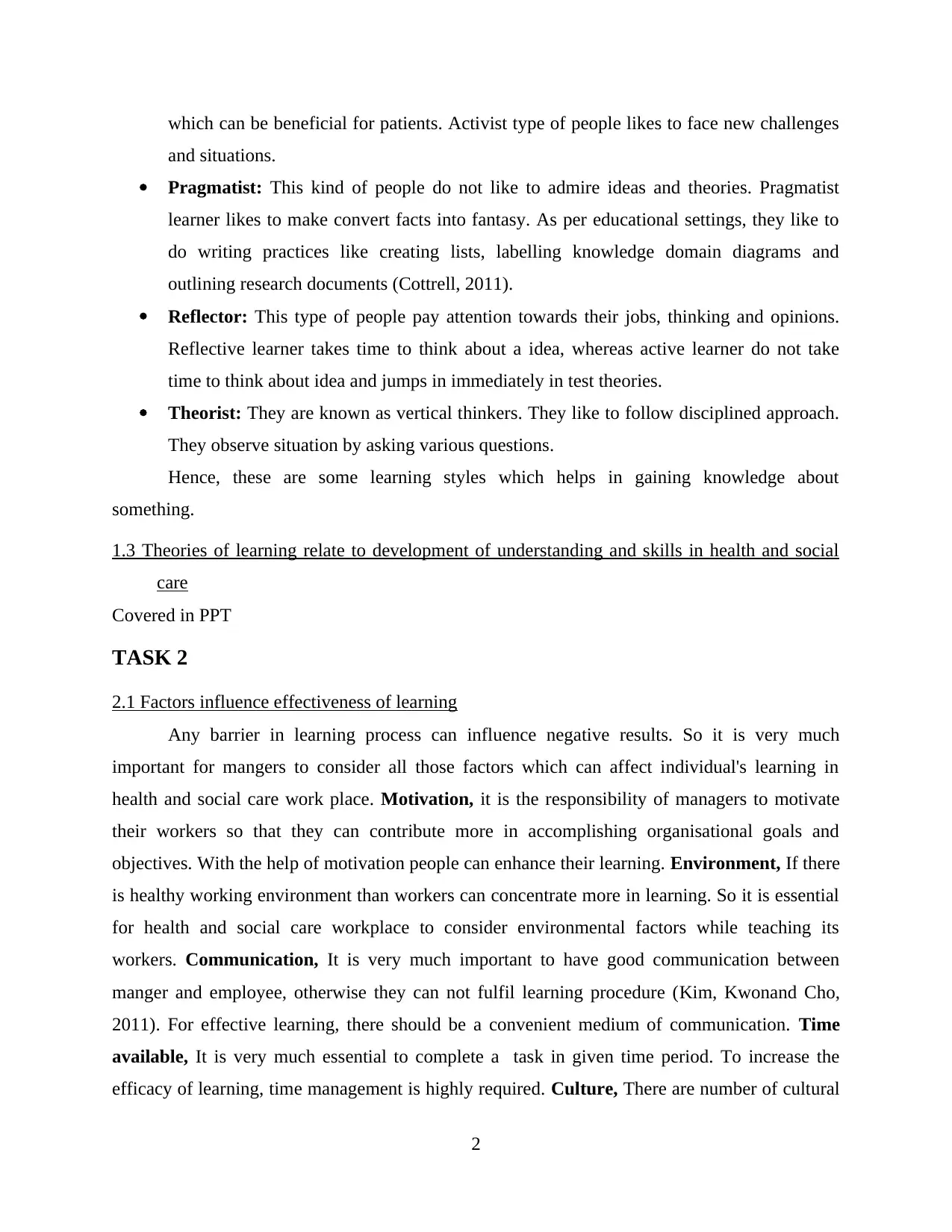
which can be beneficial for patients. Activist type of people likes to face new challenges
and situations.
Pragmatist: This kind of people do not like to admire ideas and theories. Pragmatist
learner likes to make convert facts into fantasy. As per educational settings, they like to
do writing practices like creating lists, labelling knowledge domain diagrams and
outlining research documents (Cottrell, 2011).
Reflector: This type of people pay attention towards their jobs, thinking and opinions.
Reflective learner takes time to think about a idea, whereas active learner do not take
time to think about idea and jumps in immediately in test theories.
Theorist: They are known as vertical thinkers. They like to follow disciplined approach.
They observe situation by asking various questions.
Hence, these are some learning styles which helps in gaining knowledge about
something.
1.3 Theories of learning relate to development of understanding and skills in health and social
care
Covered in PPT
TASK 2
2.1 Factors influence effectiveness of learning
Any barrier in learning process can influence negative results. So it is very much
important for mangers to consider all those factors which can affect individual's learning in
health and social care work place. Motivation, it is the responsibility of managers to motivate
their workers so that they can contribute more in accomplishing organisational goals and
objectives. With the help of motivation people can enhance their learning. Environment, If there
is healthy working environment than workers can concentrate more in learning. So it is essential
for health and social care workplace to consider environmental factors while teaching its
workers. Communication, It is very much important to have good communication between
manger and employee, otherwise they can not fulfil learning procedure (Kim, Kwonand Cho,
2011). For effective learning, there should be a convenient medium of communication. Time
available, It is very much essential to complete a task in given time period. To increase the
efficacy of learning, time management is highly required. Culture, There are number of cultural
2
and situations.
Pragmatist: This kind of people do not like to admire ideas and theories. Pragmatist
learner likes to make convert facts into fantasy. As per educational settings, they like to
do writing practices like creating lists, labelling knowledge domain diagrams and
outlining research documents (Cottrell, 2011).
Reflector: This type of people pay attention towards their jobs, thinking and opinions.
Reflective learner takes time to think about a idea, whereas active learner do not take
time to think about idea and jumps in immediately in test theories.
Theorist: They are known as vertical thinkers. They like to follow disciplined approach.
They observe situation by asking various questions.
Hence, these are some learning styles which helps in gaining knowledge about
something.
1.3 Theories of learning relate to development of understanding and skills in health and social
care
Covered in PPT
TASK 2
2.1 Factors influence effectiveness of learning
Any barrier in learning process can influence negative results. So it is very much
important for mangers to consider all those factors which can affect individual's learning in
health and social care work place. Motivation, it is the responsibility of managers to motivate
their workers so that they can contribute more in accomplishing organisational goals and
objectives. With the help of motivation people can enhance their learning. Environment, If there
is healthy working environment than workers can concentrate more in learning. So it is essential
for health and social care workplace to consider environmental factors while teaching its
workers. Communication, It is very much important to have good communication between
manger and employee, otherwise they can not fulfil learning procedure (Kim, Kwonand Cho,
2011). For effective learning, there should be a convenient medium of communication. Time
available, It is very much essential to complete a task in given time period. To increase the
efficacy of learning, time management is highly required. Culture, There are number of cultural
2
Paraphrase This Document
Need a fresh take? Get an instant paraphrase of this document with our AI Paraphraser
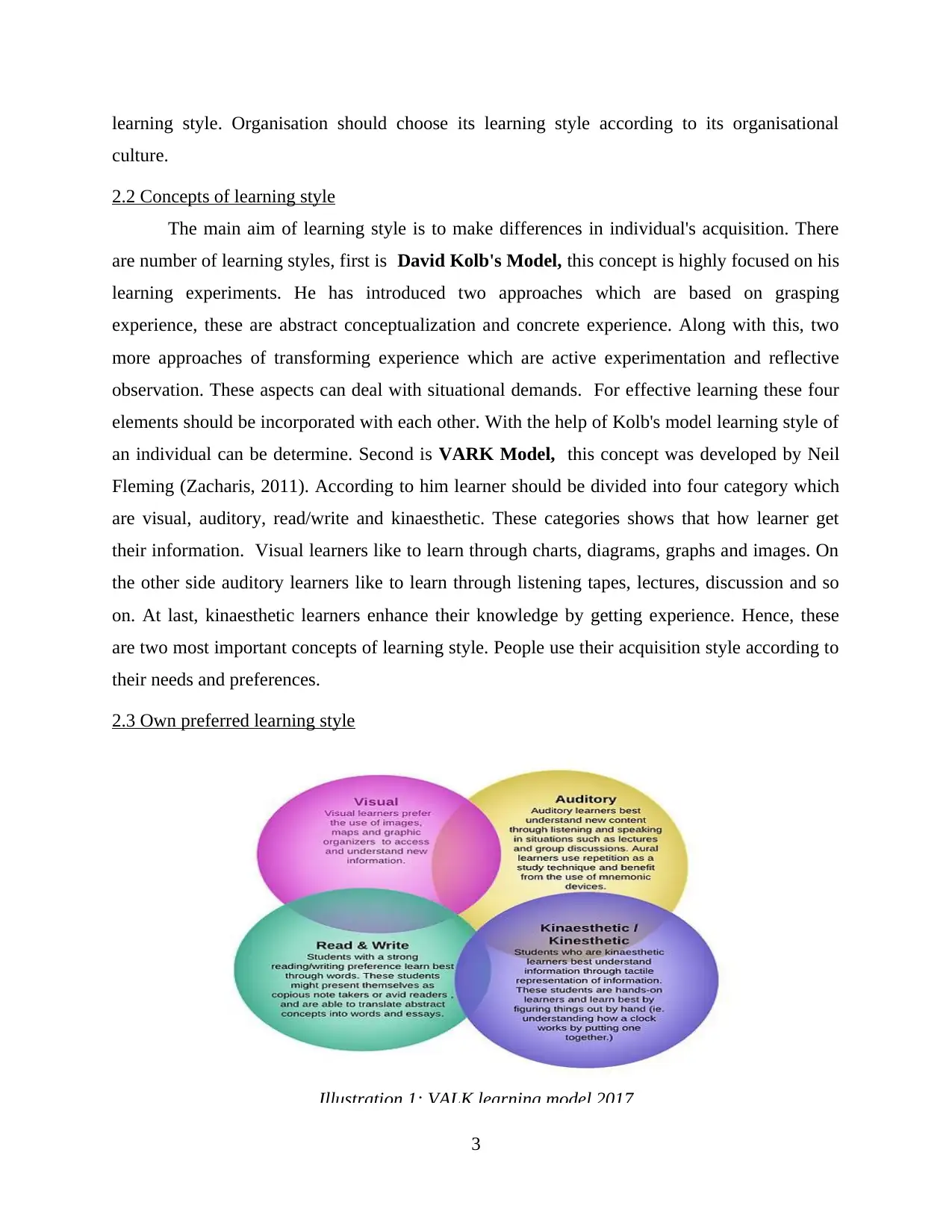
learning style. Organisation should choose its learning style according to its organisational
culture.
2.2 Concepts of learning style
The main aim of learning style is to make differences in individual's acquisition. There
are number of learning styles, first is David Kolb's Model, this concept is highly focused on his
learning experiments. He has introduced two approaches which are based on grasping
experience, these are abstract conceptualization and concrete experience. Along with this, two
more approaches of transforming experience which are active experimentation and reflective
observation. These aspects can deal with situational demands. For effective learning these four
elements should be incorporated with each other. With the help of Kolb's model learning style of
an individual can be determine. Second is VARK Model, this concept was developed by Neil
Fleming (Zacharis, 2011). According to him learner should be divided into four category which
are visual, auditory, read/write and kinaesthetic. These categories shows that how learner get
their information. Visual learners like to learn through charts, diagrams, graphs and images. On
the other side auditory learners like to learn through listening tapes, lectures, discussion and so
on. At last, kinaesthetic learners enhance their knowledge by getting experience. Hence, these
are two most important concepts of learning style. People use their acquisition style according to
their needs and preferences.
2.3 Own preferred learning style
3
Illustration 1: VALK learning model.2017
culture.
2.2 Concepts of learning style
The main aim of learning style is to make differences in individual's acquisition. There
are number of learning styles, first is David Kolb's Model, this concept is highly focused on his
learning experiments. He has introduced two approaches which are based on grasping
experience, these are abstract conceptualization and concrete experience. Along with this, two
more approaches of transforming experience which are active experimentation and reflective
observation. These aspects can deal with situational demands. For effective learning these four
elements should be incorporated with each other. With the help of Kolb's model learning style of
an individual can be determine. Second is VARK Model, this concept was developed by Neil
Fleming (Zacharis, 2011). According to him learner should be divided into four category which
are visual, auditory, read/write and kinaesthetic. These categories shows that how learner get
their information. Visual learners like to learn through charts, diagrams, graphs and images. On
the other side auditory learners like to learn through listening tapes, lectures, discussion and so
on. At last, kinaesthetic learners enhance their knowledge by getting experience. Hence, these
are two most important concepts of learning style. People use their acquisition style according to
their needs and preferences.
2.3 Own preferred learning style
3
Illustration 1: VALK learning model.2017
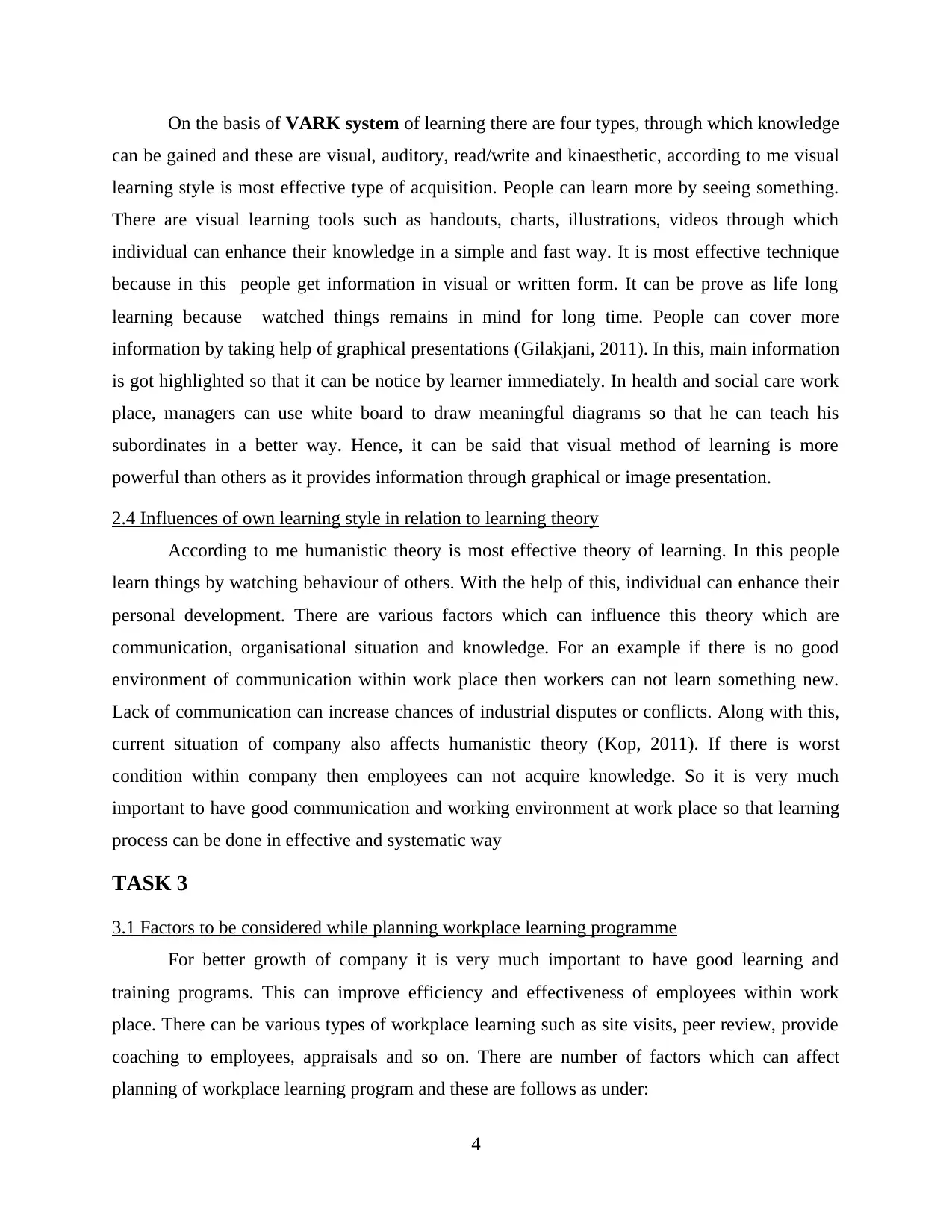
On the basis of VARK system of learning there are four types, through which knowledge
can be gained and these are visual, auditory, read/write and kinaesthetic, according to me visual
learning style is most effective type of acquisition. People can learn more by seeing something.
There are visual learning tools such as handouts, charts, illustrations, videos through which
individual can enhance their knowledge in a simple and fast way. It is most effective technique
because in this people get information in visual or written form. It can be prove as life long
learning because watched things remains in mind for long time. People can cover more
information by taking help of graphical presentations (Gilakjani, 2011). In this, main information
is got highlighted so that it can be notice by learner immediately. In health and social care work
place, managers can use white board to draw meaningful diagrams so that he can teach his
subordinates in a better way. Hence, it can be said that visual method of learning is more
powerful than others as it provides information through graphical or image presentation.
2.4 Influences of own learning style in relation to learning theory
According to me humanistic theory is most effective theory of learning. In this people
learn things by watching behaviour of others. With the help of this, individual can enhance their
personal development. There are various factors which can influence this theory which are
communication, organisational situation and knowledge. For an example if there is no good
environment of communication within work place then workers can not learn something new.
Lack of communication can increase chances of industrial disputes or conflicts. Along with this,
current situation of company also affects humanistic theory (Kop, 2011). If there is worst
condition within company then employees can not acquire knowledge. So it is very much
important to have good communication and working environment at work place so that learning
process can be done in effective and systematic way
TASK 3
3.1 Factors to be considered while planning workplace learning programme
For better growth of company it is very much important to have good learning and
training programs. This can improve efficiency and effectiveness of employees within work
place. There can be various types of workplace learning such as site visits, peer review, provide
coaching to employees, appraisals and so on. There are number of factors which can affect
planning of workplace learning program and these are follows as under:
4
can be gained and these are visual, auditory, read/write and kinaesthetic, according to me visual
learning style is most effective type of acquisition. People can learn more by seeing something.
There are visual learning tools such as handouts, charts, illustrations, videos through which
individual can enhance their knowledge in a simple and fast way. It is most effective technique
because in this people get information in visual or written form. It can be prove as life long
learning because watched things remains in mind for long time. People can cover more
information by taking help of graphical presentations (Gilakjani, 2011). In this, main information
is got highlighted so that it can be notice by learner immediately. In health and social care work
place, managers can use white board to draw meaningful diagrams so that he can teach his
subordinates in a better way. Hence, it can be said that visual method of learning is more
powerful than others as it provides information through graphical or image presentation.
2.4 Influences of own learning style in relation to learning theory
According to me humanistic theory is most effective theory of learning. In this people
learn things by watching behaviour of others. With the help of this, individual can enhance their
personal development. There are various factors which can influence this theory which are
communication, organisational situation and knowledge. For an example if there is no good
environment of communication within work place then workers can not learn something new.
Lack of communication can increase chances of industrial disputes or conflicts. Along with this,
current situation of company also affects humanistic theory (Kop, 2011). If there is worst
condition within company then employees can not acquire knowledge. So it is very much
important to have good communication and working environment at work place so that learning
process can be done in effective and systematic way
TASK 3
3.1 Factors to be considered while planning workplace learning programme
For better growth of company it is very much important to have good learning and
training programs. This can improve efficiency and effectiveness of employees within work
place. There can be various types of workplace learning such as site visits, peer review, provide
coaching to employees, appraisals and so on. There are number of factors which can affect
planning of workplace learning program and these are follows as under:
4
⊘ This is a preview!⊘
Do you want full access?
Subscribe today to unlock all pages.

Trusted by 1+ million students worldwide
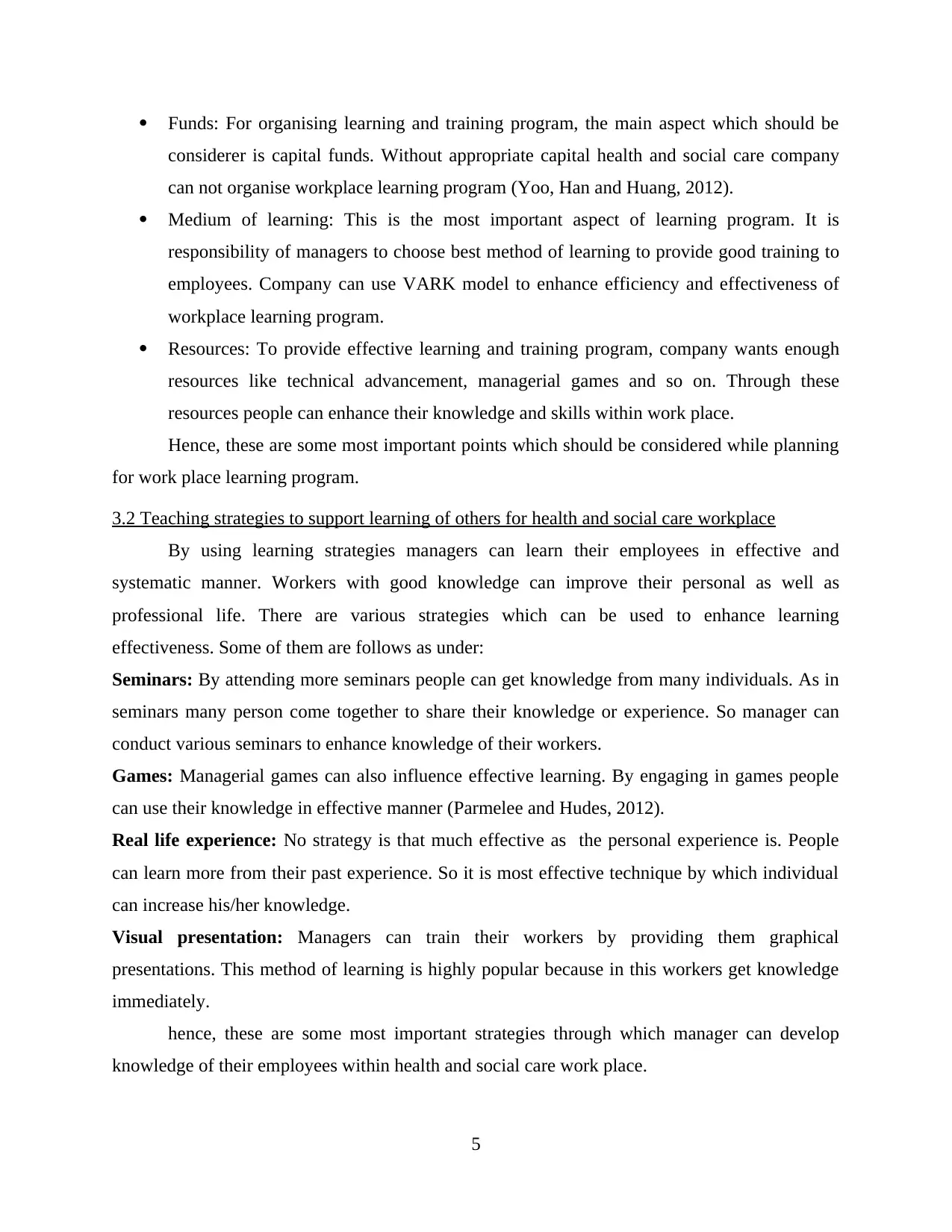
Funds: For organising learning and training program, the main aspect which should be
considerer is capital funds. Without appropriate capital health and social care company
can not organise workplace learning program (Yoo, Han and Huang, 2012).
Medium of learning: This is the most important aspect of learning program. It is
responsibility of managers to choose best method of learning to provide good training to
employees. Company can use VARK model to enhance efficiency and effectiveness of
workplace learning program.
Resources: To provide effective learning and training program, company wants enough
resources like technical advancement, managerial games and so on. Through these
resources people can enhance their knowledge and skills within work place.
Hence, these are some most important points which should be considered while planning
for work place learning program.
3.2 Teaching strategies to support learning of others for health and social care workplace
By using learning strategies managers can learn their employees in effective and
systematic manner. Workers with good knowledge can improve their personal as well as
professional life. There are various strategies which can be used to enhance learning
effectiveness. Some of them are follows as under:
Seminars: By attending more seminars people can get knowledge from many individuals. As in
seminars many person come together to share their knowledge or experience. So manager can
conduct various seminars to enhance knowledge of their workers.
Games: Managerial games can also influence effective learning. By engaging in games people
can use their knowledge in effective manner (Parmelee and Hudes, 2012).
Real life experience: No strategy is that much effective as the personal experience is. People
can learn more from their past experience. So it is most effective technique by which individual
can increase his/her knowledge.
Visual presentation: Managers can train their workers by providing them graphical
presentations. This method of learning is highly popular because in this workers get knowledge
immediately.
hence, these are some most important strategies through which manager can develop
knowledge of their employees within health and social care work place.
5
considerer is capital funds. Without appropriate capital health and social care company
can not organise workplace learning program (Yoo, Han and Huang, 2012).
Medium of learning: This is the most important aspect of learning program. It is
responsibility of managers to choose best method of learning to provide good training to
employees. Company can use VARK model to enhance efficiency and effectiveness of
workplace learning program.
Resources: To provide effective learning and training program, company wants enough
resources like technical advancement, managerial games and so on. Through these
resources people can enhance their knowledge and skills within work place.
Hence, these are some most important points which should be considered while planning
for work place learning program.
3.2 Teaching strategies to support learning of others for health and social care workplace
By using learning strategies managers can learn their employees in effective and
systematic manner. Workers with good knowledge can improve their personal as well as
professional life. There are various strategies which can be used to enhance learning
effectiveness. Some of them are follows as under:
Seminars: By attending more seminars people can get knowledge from many individuals. As in
seminars many person come together to share their knowledge or experience. So manager can
conduct various seminars to enhance knowledge of their workers.
Games: Managerial games can also influence effective learning. By engaging in games people
can use their knowledge in effective manner (Parmelee and Hudes, 2012).
Real life experience: No strategy is that much effective as the personal experience is. People
can learn more from their past experience. So it is most effective technique by which individual
can increase his/her knowledge.
Visual presentation: Managers can train their workers by providing them graphical
presentations. This method of learning is highly popular because in this workers get knowledge
immediately.
hence, these are some most important strategies through which manager can develop
knowledge of their employees within health and social care work place.
5
Paraphrase This Document
Need a fresh take? Get an instant paraphrase of this document with our AI Paraphraser
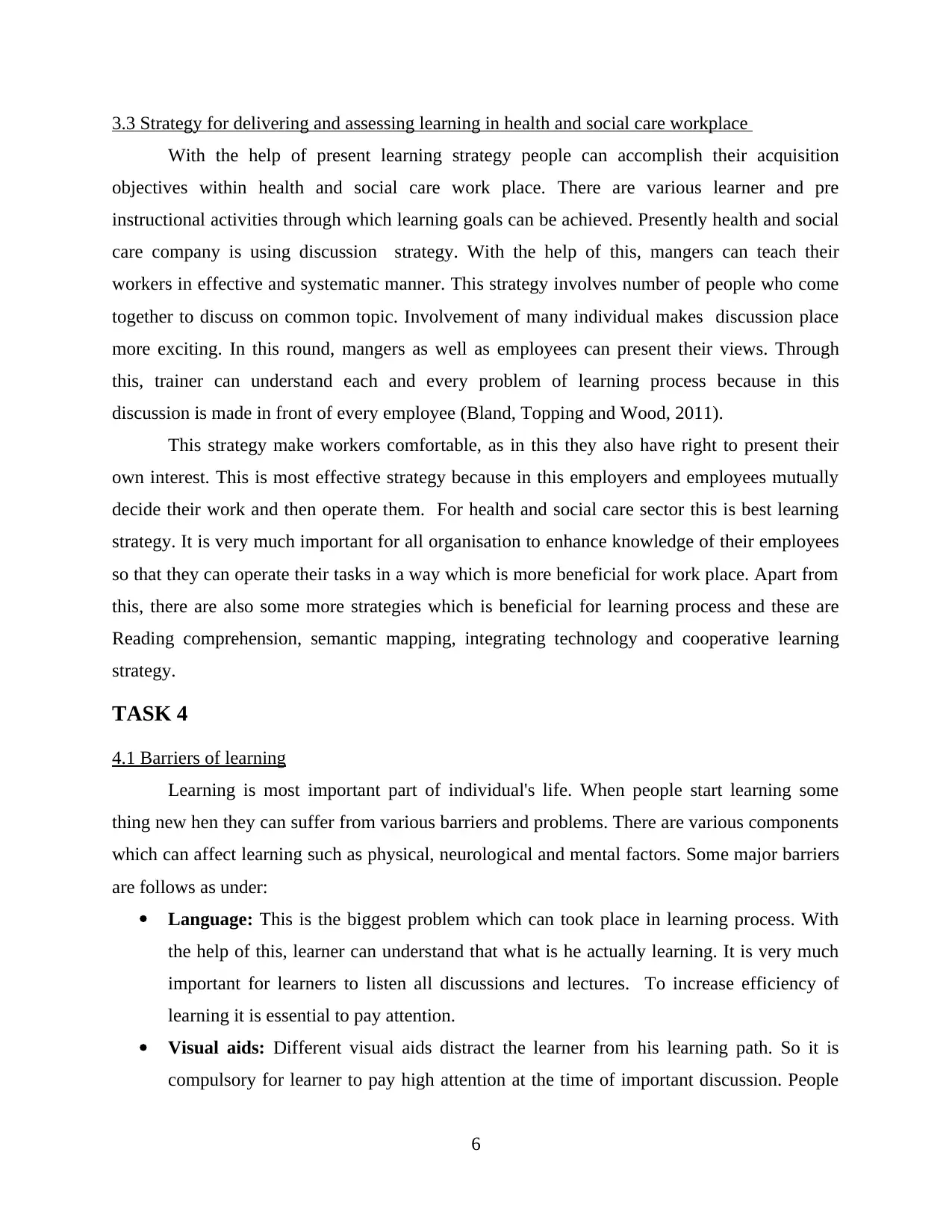
3.3 Strategy for delivering and assessing learning in health and social care workplace
With the help of present learning strategy people can accomplish their acquisition
objectives within health and social care work place. There are various learner and pre
instructional activities through which learning goals can be achieved. Presently health and social
care company is using discussion strategy. With the help of this, mangers can teach their
workers in effective and systematic manner. This strategy involves number of people who come
together to discuss on common topic. Involvement of many individual makes discussion place
more exciting. In this round, mangers as well as employees can present their views. Through
this, trainer can understand each and every problem of learning process because in this
discussion is made in front of every employee (Bland, Topping and Wood, 2011).
This strategy make workers comfortable, as in this they also have right to present their
own interest. This is most effective strategy because in this employers and employees mutually
decide their work and then operate them. For health and social care sector this is best learning
strategy. It is very much important for all organisation to enhance knowledge of their employees
so that they can operate their tasks in a way which is more beneficial for work place. Apart from
this, there are also some more strategies which is beneficial for learning process and these are
Reading comprehension, semantic mapping, integrating technology and cooperative learning
strategy.
TASK 4
4.1 Barriers of learning
Learning is most important part of individual's life. When people start learning some
thing new hen they can suffer from various barriers and problems. There are various components
which can affect learning such as physical, neurological and mental factors. Some major barriers
are follows as under:
Language: This is the biggest problem which can took place in learning process. With
the help of this, learner can understand that what is he actually learning. It is very much
important for learners to listen all discussions and lectures. To increase efficiency of
learning it is essential to pay attention.
Visual aids: Different visual aids distract the learner from his learning path. So it is
compulsory for learner to pay high attention at the time of important discussion. People
6
With the help of present learning strategy people can accomplish their acquisition
objectives within health and social care work place. There are various learner and pre
instructional activities through which learning goals can be achieved. Presently health and social
care company is using discussion strategy. With the help of this, mangers can teach their
workers in effective and systematic manner. This strategy involves number of people who come
together to discuss on common topic. Involvement of many individual makes discussion place
more exciting. In this round, mangers as well as employees can present their views. Through
this, trainer can understand each and every problem of learning process because in this
discussion is made in front of every employee (Bland, Topping and Wood, 2011).
This strategy make workers comfortable, as in this they also have right to present their
own interest. This is most effective strategy because in this employers and employees mutually
decide their work and then operate them. For health and social care sector this is best learning
strategy. It is very much important for all organisation to enhance knowledge of their employees
so that they can operate their tasks in a way which is more beneficial for work place. Apart from
this, there are also some more strategies which is beneficial for learning process and these are
Reading comprehension, semantic mapping, integrating technology and cooperative learning
strategy.
TASK 4
4.1 Barriers of learning
Learning is most important part of individual's life. When people start learning some
thing new hen they can suffer from various barriers and problems. There are various components
which can affect learning such as physical, neurological and mental factors. Some major barriers
are follows as under:
Language: This is the biggest problem which can took place in learning process. With
the help of this, learner can understand that what is he actually learning. It is very much
important for learners to listen all discussions and lectures. To increase efficiency of
learning it is essential to pay attention.
Visual aids: Different visual aids distract the learner from his learning path. So it is
compulsory for learner to pay high attention at the time of important discussion. People
6
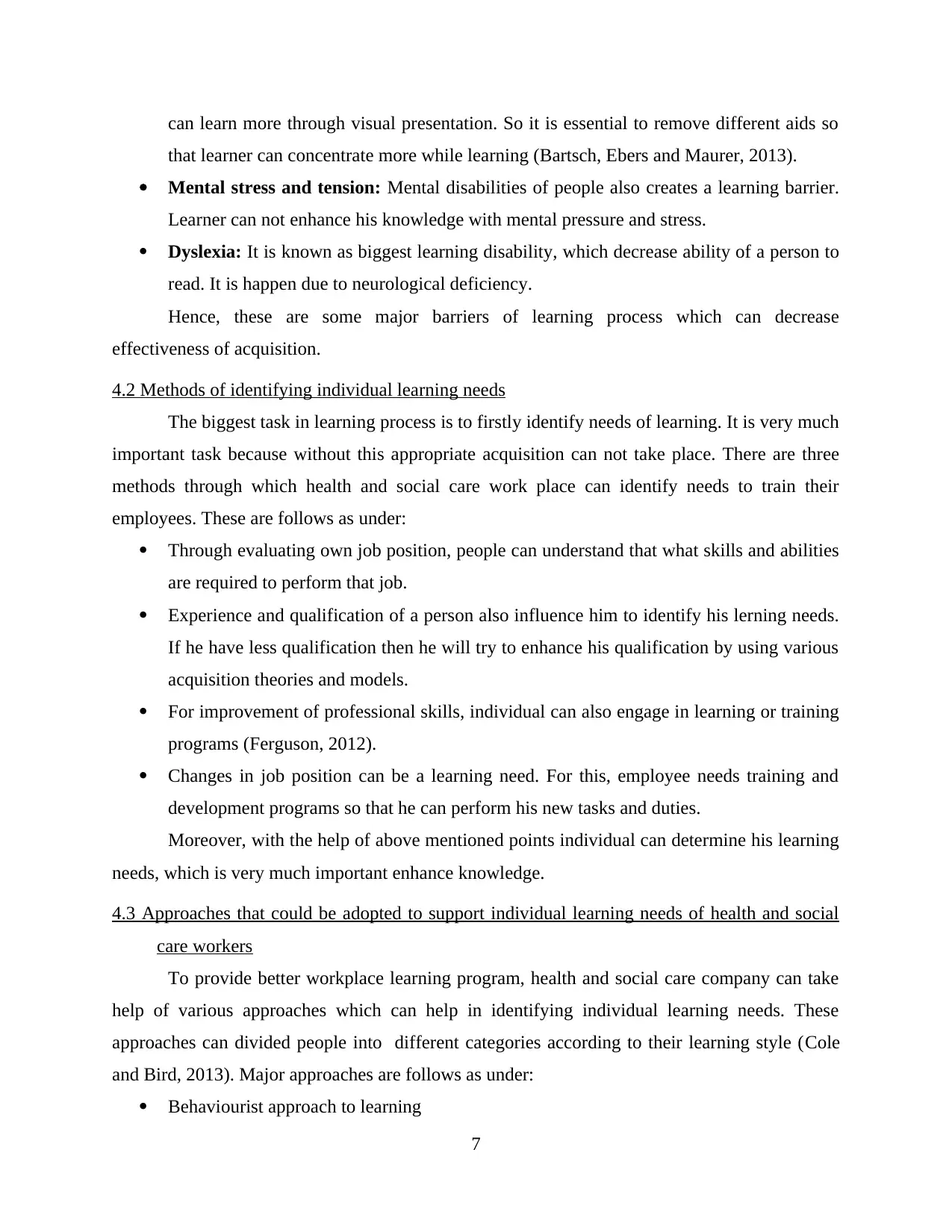
can learn more through visual presentation. So it is essential to remove different aids so
that learner can concentrate more while learning (Bartsch, Ebers and Maurer, 2013).
Mental stress and tension: Mental disabilities of people also creates a learning barrier.
Learner can not enhance his knowledge with mental pressure and stress.
Dyslexia: It is known as biggest learning disability, which decrease ability of a person to
read. It is happen due to neurological deficiency.
Hence, these are some major barriers of learning process which can decrease
effectiveness of acquisition.
4.2 Methods of identifying individual learning needs
The biggest task in learning process is to firstly identify needs of learning. It is very much
important task because without this appropriate acquisition can not take place. There are three
methods through which health and social care work place can identify needs to train their
employees. These are follows as under:
Through evaluating own job position, people can understand that what skills and abilities
are required to perform that job.
Experience and qualification of a person also influence him to identify his lerning needs.
If he have less qualification then he will try to enhance his qualification by using various
acquisition theories and models.
For improvement of professional skills, individual can also engage in learning or training
programs (Ferguson, 2012).
Changes in job position can be a learning need. For this, employee needs training and
development programs so that he can perform his new tasks and duties.
Moreover, with the help of above mentioned points individual can determine his learning
needs, which is very much important enhance knowledge.
4.3 Approaches that could be adopted to support individual learning needs of health and social
care workers
To provide better workplace learning program, health and social care company can take
help of various approaches which can help in identifying individual learning needs. These
approaches can divided people into different categories according to their learning style (Cole
and Bird, 2013). Major approaches are follows as under:
Behaviourist approach to learning
7
that learner can concentrate more while learning (Bartsch, Ebers and Maurer, 2013).
Mental stress and tension: Mental disabilities of people also creates a learning barrier.
Learner can not enhance his knowledge with mental pressure and stress.
Dyslexia: It is known as biggest learning disability, which decrease ability of a person to
read. It is happen due to neurological deficiency.
Hence, these are some major barriers of learning process which can decrease
effectiveness of acquisition.
4.2 Methods of identifying individual learning needs
The biggest task in learning process is to firstly identify needs of learning. It is very much
important task because without this appropriate acquisition can not take place. There are three
methods through which health and social care work place can identify needs to train their
employees. These are follows as under:
Through evaluating own job position, people can understand that what skills and abilities
are required to perform that job.
Experience and qualification of a person also influence him to identify his lerning needs.
If he have less qualification then he will try to enhance his qualification by using various
acquisition theories and models.
For improvement of professional skills, individual can also engage in learning or training
programs (Ferguson, 2012).
Changes in job position can be a learning need. For this, employee needs training and
development programs so that he can perform his new tasks and duties.
Moreover, with the help of above mentioned points individual can determine his learning
needs, which is very much important enhance knowledge.
4.3 Approaches that could be adopted to support individual learning needs of health and social
care workers
To provide better workplace learning program, health and social care company can take
help of various approaches which can help in identifying individual learning needs. These
approaches can divided people into different categories according to their learning style (Cole
and Bird, 2013). Major approaches are follows as under:
Behaviourist approach to learning
7
⊘ This is a preview!⊘
Do you want full access?
Subscribe today to unlock all pages.

Trusted by 1+ million students worldwide
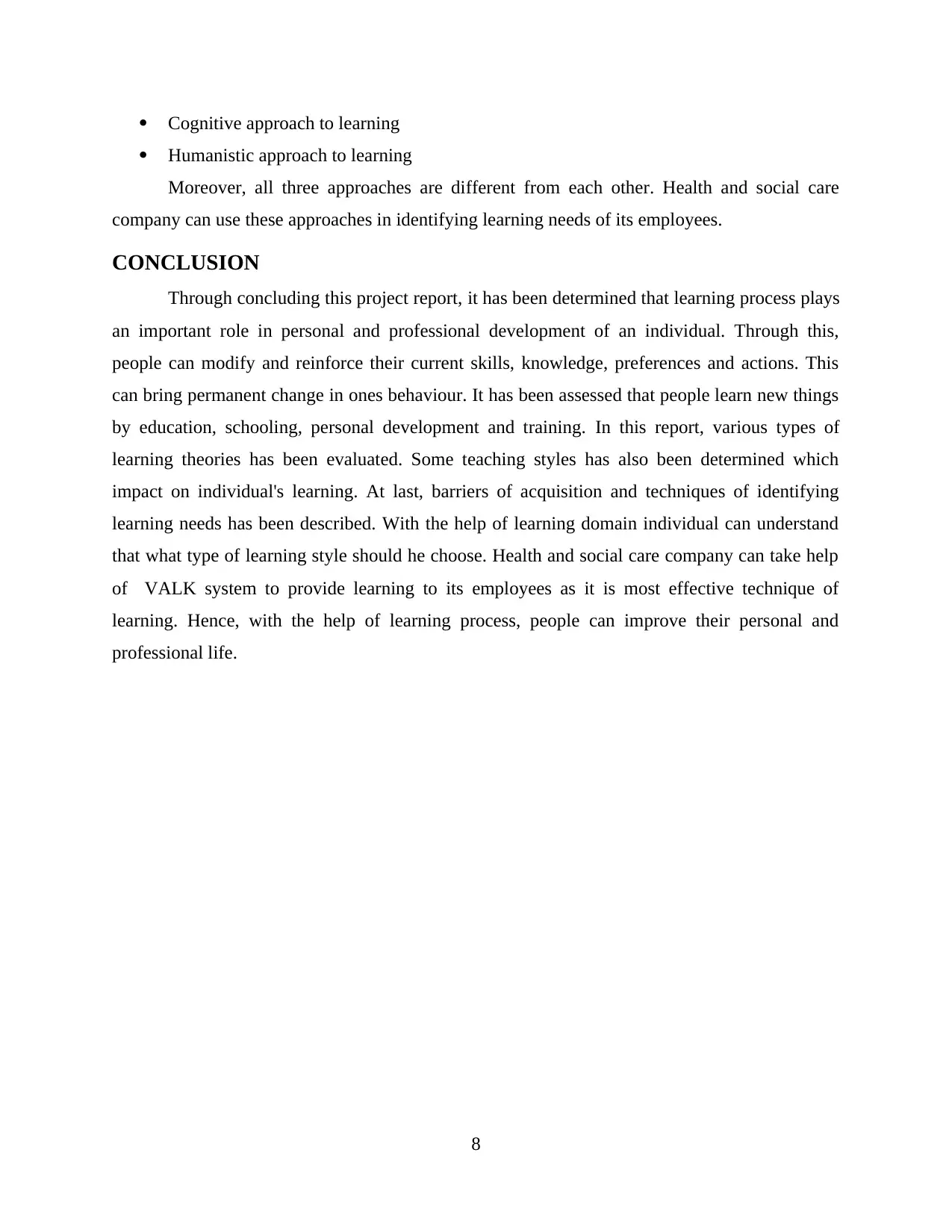
Cognitive approach to learning
Humanistic approach to learning
Moreover, all three approaches are different from each other. Health and social care
company can use these approaches in identifying learning needs of its employees.
CONCLUSION
Through concluding this project report, it has been determined that learning process plays
an important role in personal and professional development of an individual. Through this,
people can modify and reinforce their current skills, knowledge, preferences and actions. This
can bring permanent change in ones behaviour. It has been assessed that people learn new things
by education, schooling, personal development and training. In this report, various types of
learning theories has been evaluated. Some teaching styles has also been determined which
impact on individual's learning. At last, barriers of acquisition and techniques of identifying
learning needs has been described. With the help of learning domain individual can understand
that what type of learning style should he choose. Health and social care company can take help
of VALK system to provide learning to its employees as it is most effective technique of
learning. Hence, with the help of learning process, people can improve their personal and
professional life.
8
Humanistic approach to learning
Moreover, all three approaches are different from each other. Health and social care
company can use these approaches in identifying learning needs of its employees.
CONCLUSION
Through concluding this project report, it has been determined that learning process plays
an important role in personal and professional development of an individual. Through this,
people can modify and reinforce their current skills, knowledge, preferences and actions. This
can bring permanent change in ones behaviour. It has been assessed that people learn new things
by education, schooling, personal development and training. In this report, various types of
learning theories has been evaluated. Some teaching styles has also been determined which
impact on individual's learning. At last, barriers of acquisition and techniques of identifying
learning needs has been described. With the help of learning domain individual can understand
that what type of learning style should he choose. Health and social care company can take help
of VALK system to provide learning to its employees as it is most effective technique of
learning. Hence, with the help of learning process, people can improve their personal and
professional life.
8
Paraphrase This Document
Need a fresh take? Get an instant paraphrase of this document with our AI Paraphraser
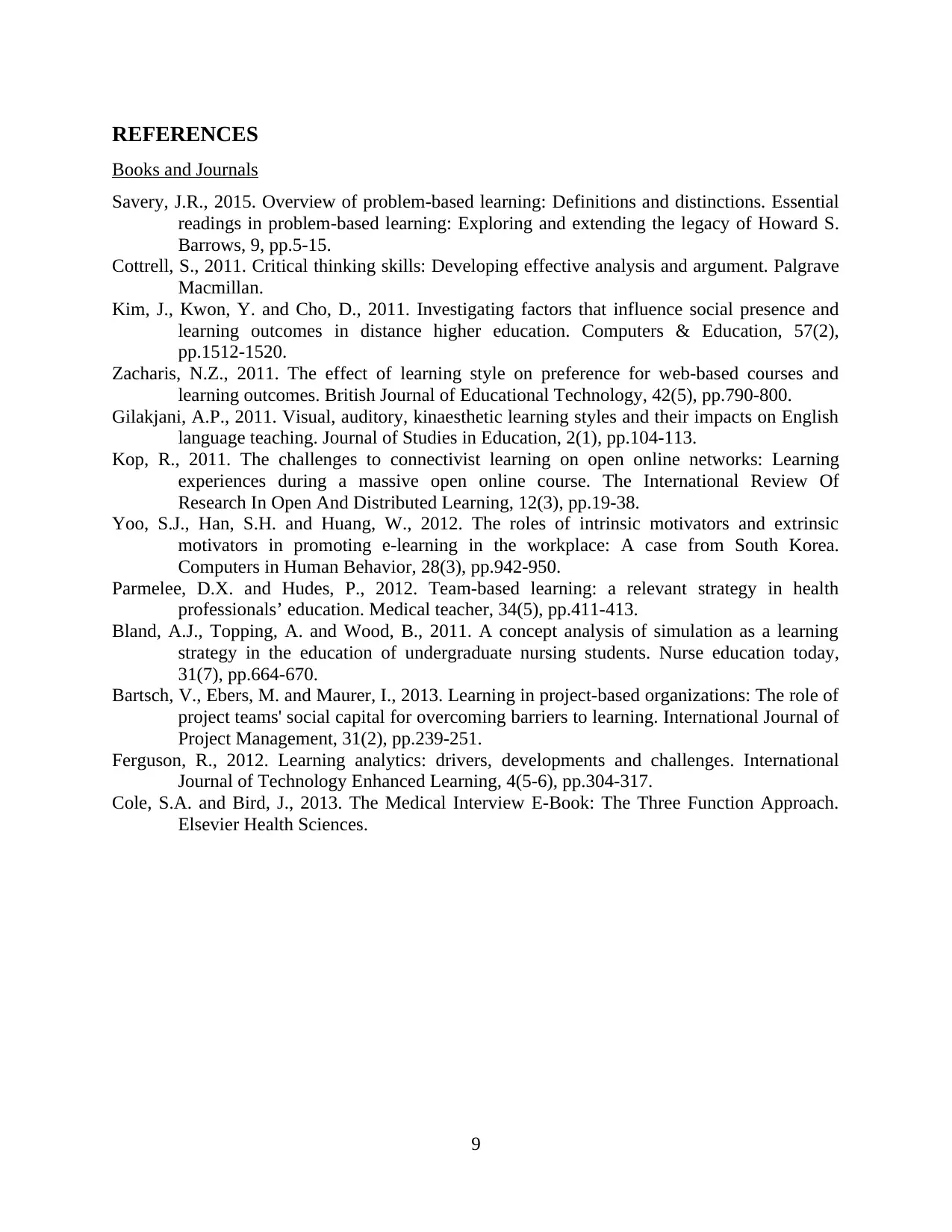
REFERENCES
Books and Journals
Savery, J.R., 2015. Overview of problem-based learning: Definitions and distinctions. Essential
readings in problem-based learning: Exploring and extending the legacy of Howard S.
Barrows, 9, pp.5-15.
Cottrell, S., 2011. Critical thinking skills: Developing effective analysis and argument. Palgrave
Macmillan.
Kim, J., Kwon, Y. and Cho, D., 2011. Investigating factors that influence social presence and
learning outcomes in distance higher education. Computers & Education, 57(2),
pp.1512-1520.
Zacharis, N.Z., 2011. The effect of learning style on preference for web‐based courses and
learning outcomes. British Journal of Educational Technology, 42(5), pp.790-800.
Gilakjani, A.P., 2011. Visual, auditory, kinaesthetic learning styles and their impacts on English
language teaching. Journal of Studies in Education, 2(1), pp.104-113.
Kop, R., 2011. The challenges to connectivist learning on open online networks: Learning
experiences during a massive open online course. The International Review Of
Research In Open And Distributed Learning, 12(3), pp.19-38.
Yoo, S.J., Han, S.H. and Huang, W., 2012. The roles of intrinsic motivators and extrinsic
motivators in promoting e-learning in the workplace: A case from South Korea.
Computers in Human Behavior, 28(3), pp.942-950.
Parmelee, D.X. and Hudes, P., 2012. Team-based learning: a relevant strategy in health
professionals’ education. Medical teacher, 34(5), pp.411-413.
Bland, A.J., Topping, A. and Wood, B., 2011. A concept analysis of simulation as a learning
strategy in the education of undergraduate nursing students. Nurse education today,
31(7), pp.664-670.
Bartsch, V., Ebers, M. and Maurer, I., 2013. Learning in project-based organizations: The role of
project teams' social capital for overcoming barriers to learning. International Journal of
Project Management, 31(2), pp.239-251.
Ferguson, R., 2012. Learning analytics: drivers, developments and challenges. International
Journal of Technology Enhanced Learning, 4(5-6), pp.304-317.
Cole, S.A. and Bird, J., 2013. The Medical Interview E-Book: The Three Function Approach.
Elsevier Health Sciences.
9
Books and Journals
Savery, J.R., 2015. Overview of problem-based learning: Definitions and distinctions. Essential
readings in problem-based learning: Exploring and extending the legacy of Howard S.
Barrows, 9, pp.5-15.
Cottrell, S., 2011. Critical thinking skills: Developing effective analysis and argument. Palgrave
Macmillan.
Kim, J., Kwon, Y. and Cho, D., 2011. Investigating factors that influence social presence and
learning outcomes in distance higher education. Computers & Education, 57(2),
pp.1512-1520.
Zacharis, N.Z., 2011. The effect of learning style on preference for web‐based courses and
learning outcomes. British Journal of Educational Technology, 42(5), pp.790-800.
Gilakjani, A.P., 2011. Visual, auditory, kinaesthetic learning styles and their impacts on English
language teaching. Journal of Studies in Education, 2(1), pp.104-113.
Kop, R., 2011. The challenges to connectivist learning on open online networks: Learning
experiences during a massive open online course. The International Review Of
Research In Open And Distributed Learning, 12(3), pp.19-38.
Yoo, S.J., Han, S.H. and Huang, W., 2012. The roles of intrinsic motivators and extrinsic
motivators in promoting e-learning in the workplace: A case from South Korea.
Computers in Human Behavior, 28(3), pp.942-950.
Parmelee, D.X. and Hudes, P., 2012. Team-based learning: a relevant strategy in health
professionals’ education. Medical teacher, 34(5), pp.411-413.
Bland, A.J., Topping, A. and Wood, B., 2011. A concept analysis of simulation as a learning
strategy in the education of undergraduate nursing students. Nurse education today,
31(7), pp.664-670.
Bartsch, V., Ebers, M. and Maurer, I., 2013. Learning in project-based organizations: The role of
project teams' social capital for overcoming barriers to learning. International Journal of
Project Management, 31(2), pp.239-251.
Ferguson, R., 2012. Learning analytics: drivers, developments and challenges. International
Journal of Technology Enhanced Learning, 4(5-6), pp.304-317.
Cole, S.A. and Bird, J., 2013. The Medical Interview E-Book: The Three Function Approach.
Elsevier Health Sciences.
9
1 out of 11
Related Documents
Your All-in-One AI-Powered Toolkit for Academic Success.
+13062052269
info@desklib.com
Available 24*7 on WhatsApp / Email
![[object Object]](/_next/static/media/star-bottom.7253800d.svg)
Unlock your academic potential
Copyright © 2020–2025 A2Z Services. All Rights Reserved. Developed and managed by ZUCOL.




